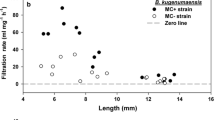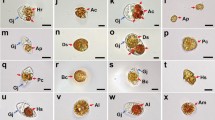Abstract
Growth and feeding activities of the tintinnid ciliate Favella taraikaensis fed the toxic dinoflagellate Alexandrium tamarense were examined in laboratory experiments. Both growth and ingestion rates of F. taraikaensis as a function of the A. tamarense concentration were fitted to a rectangular hyperbolic equation. The maximum growth and ingestion rates of F. taraikaensis were 1.0 day−1 and 2.8 cells ind. h−1 (carbon specific ingestion rates: 3.5 day−1), respectively, which are both included in the range of previous data reported for Favella spp. feeding on other algae. The gross growth efficiency (GGE) of F. taraikaensis ranged from 0.26 to 0.49 (mean value 0.40) at the concentration of 10–800 cells ml−1, which is within the range of previous data on Favella spp. Also, the growth and ingestion rates and GGE of F. taraikaensis on A. tamarense were not significantly different from the values on another non-toxic dinoflagellate (Heterocapsa triquetra) at two different prey concentrations. This indicates that the toxicity of A. tamarense probably did not influence the feeding and growth activities of F. taraikaensis at concentrations of less than ca. 800 cells ml−1. To evaluate the grazing by F. taraikaensis on A. tamarense blooms in the field, the population dynamics of A. tamarense were simulated based on the growth and ingestion parameters of F. taraikaensis. As a result, the grazing impact by F. taraikaensis was considered to potentially regulate the development of A. tamarense blooms. If the toxicity of A. tamarense does not influence the growth and feeding activities of F. taraikaensis, the occurrence of such grazer plankton are considered to be important for predicting the course of A. tamarense bloom dynamics under natural conditions.




Similar content being viewed by others
References
Aelion CM, Chisholm SW (1985) Effect of temperature on growth and ingestion rates of Favella sp. J Plankton Res 7:821–830
Boyer GL, Sullivan JJ, Anderson RJ, Harrison PJ, Taylor FJR (1987) Effects of nutrient limitation on toxin production and composition in the marine dinoflagellate Protogonyaulax tamarensis. Mar Biol 96:123–128
Capliuro GM (1982) Feeding of field collected tintinnid micro-zooplankton on natural food. Mar Biol 71:73–86
Dutz J (1998) Repression of fecundity in the neritic copepod Acartia clausi exposed to the toxic dinoflagellate Alexandrium lusitanicum: relationship between feeding and egg production. Mar Ecol Prog Ser 175:97–107
Frost BW (1972) Effects of size and concentration of food particles on the feeding behavior of the marine planktonic copepod Calanus pacificus. Limnol Oceanogr 17:805–815
Hallegraeff GM (1993) A review of harmful algal blooms and their apparent global increase. Phycologia 32:79–99
Hamasaki K, Horie M, Tokimitsu S, Toda T, Taguchi S (2001) Variability in toxicity of the dinoflagellate Alexandrium tamarense isolated from Hiroshima Bay, western Japan, as a reflection of changing environmental conditions. J Plankton Res 23:271–278
Hamasaki K, Takahashi T, Uye S (2003) Accumulation of paralytic shellfish poisoning toxins in planktonic copepods during a bloom of the toxic dinoflagellate Alexandrium tamarense in Hiroshima Bay, western Japan. Mar Biol 143:981–988
Hansen PJ (1989) The red tide dinoflagellate Alexandrium tamarense: effects on behaviour and growth of a tintinnid ciliate. Mar Ecol Prog Ser 53:105–116
Hansen PJ, Cembella AD, Moestrupφ(1992) The marine dinoflagellate Alexandrium ostenfeldii : paralytic shellfish toxin concentration, composition, and toxicity to a tintinnid ciliate. J Phycol 28:597–603
Hansen PJ, Bjørnsen PK, Hansen BW (1997) Zooplankton grazing and growth: scaling within the 2–2000-µm body size range. Limnol Oceanogr 42:687–704
Heinbokel JF (1978) Studies on the functional role of tintinnids in the southern California Bight. I. Grazing and growth rates in laboratory cultures. Mar Biol 47:177–189
Ichimi K, Suzuki T, Ito A (2002) Variety of PSP toxin profiles in various culture strains of Alexandrium tamarense and change of toxin profile in natural A. tamarense population. J Exp Mar Biol Ecol 273:51–60
Itoh K, Imai I (1987) Rafido so (Raphidophyceae). Japan fisheries resource conservation association. A guide for studies of red tide organisms. Shuwa, Tokyo
Jakobsen HH, Hansen PJ (1997) Prey size selection, grazing and growth response of the small heterotrophic dinoflagellate Gymnodinium sp. and the ciliate Balanion comatum—a comparative study. Mar Ecol Prog Ser 158:75–86
Kamiyama T (1997) Growth and grazing responses of tintinnid ciliates feeding on the toxic dinoflagellate Heterocapsa circularisquama. Mar Biol 128:509–515
Kamiyama T (1999) Feeding ecology of marine ciliates in coastal waters (Review). Bull Plankton Soc Jpn 46:113–133
Kamiyama T, Tsujino M (1996) Seasonal variation in the species composition of tintinnid ciliates in Hiroshima Bay, the Seto Inland Sea of Japan. J Plankton Res 18:2313–2327
Larocque R, Cembella AD (1990) Ecological parameters associated with the seasonal occurrence of Alexandrium spp. and consequent shellfish toxicity in the lower St Lawrence estuary (Eastern Canada). In: Granéli EP, Sundström B, Edler L, Anderson DM (eds) Toxic marine phytoplankton. Elsevier, New York, pp 368–373
Menden-Deuer S, Lessard EJ (2000) Carbon to volume relationships for dinoflagellates, diatoms, and other protist plankton. Limnol Oceanogr 45:569–579
Nakamura Y, Suzuki S, Hiromi J (1995) Population dynamics of heterotrophic dinoflagellates during a Gymnodinium mikimotoi red tide in the Seto Inland Sea. Mar Ecol Prog Ser 125:269–277
Nakamura Y, Suzuki S, Hiromi J (1996) Development and collapse of a Gymnodinium mikimotoi red tide in the Seto Inland Sea. Aquat Microb Ecol 10:131–137
Nomura H, Ishimaru T, Murano M (1992) Microzooplankton assemblage and its seasonal variation. La Mer 30:57–72
Ogata T, Ishimaru T, Kodama M (1987) Effect of water temperature and light intensity on growth rate and toxicity change in Protogonyaulax tamrarensis. Mar Biol 95: 217–220
Oshima Y (1995) Post-column derivatization HPLC methods for paralytic shellfish poisons. In: Hallegraeff GM, Anderson DM, Cembella AD (eds) Manual on harmful marine microalgae. IOC Manuals and Guides no. 33. UNESCO, pp 81–94
Oshima Y, Sugino K, Itakura H, Hirota M, Yasumoto T (1990) Comparative studies on paralytic shellfish toxin profile of dinoflagellates and bivalves. In: Granéli E, Sundström B, Edler L, Anderson DM (eds) Toxic marine phytoplankton. Elsevier, New York, pp 391–396
Pierce RW, Turner JT (1992) Ecology of planktonic ciliates in marine food webs. Rev Aquat Sci 6:139–181
Putt M, Stoecker DK (1989) An experimentally determined carbon:volume ratio for marine “oligotrichous” ciliates from estuarine and coastal waters. Limnol Oceanogr 34:1097–1103
Sakamoto S, Kotani Y (1998) Variation of paralytic shellfish toxin contents and composition in Alexandrium tamarense collected at Kure Bay, Hiroshima Prefecture. Bull Nansei Natl Fish Res Inst 31:45–52
Stoecker DK (1988) Are marine planktonic ciliates suspension-feeders? J Protozool 35:252–255
Stoecker DK, Evans GT (1985) Effects of protozoan herbivory and carnivory in a microplankton food web. Mar Ecol Prog Ser 25:159–167
Stoecker DK, Guillard RRL (1982) Effects of temperature and light on the feeding rate of Favella sp. (Ciliated Protozoa, suborder Tintinnina). Ann Inst Océanogr Paris 58:309–318
Stoecker DK, Guillard RRL, Kavee RM (1981) Selective predation by Favella ehrenbergii (Tintinnina) on and among dinoflagellates. Biol Bull 160:136–145
Stoecker DK, Silver MW, Michaels AE, Davis LH (1988) Obligate mixotrophy in Laboea strobila, a ciliate which retains chloroplasts. Mar Biol 99:415–423
Taniguchi A, Kawakami R (1985) Feeding activity of a tintinnid ciliate Favella taraikaensis and its variability observed in laboratory cultures. Mar Microb Food Webs 1:17–34
Taniguchi A, Takeda Y (1988) Feeding rate and behavior of the tintinnid ciliate Favella taraikaensis observed with a high speed VTR system. Mar Microb Food Webs 3:21–34
Tarutani K (1999) Ecophysiological studies on the population dynamics of toxic dinoflagellate Alexandrium tamarense. Bull Fish Environ Inland Sea 1:63–96
Tillmann U, John U (2002) Toxic effects of Alexandrium spp. on heterotrophic dinoflagellates: an allelochemical defense mechanism independent of PSP-toxin content. Mar Ecol Prog Ser 230:47–58
Turner JT, Tester PA, Hansen PJ (1998) Interactions between toxic marine phytoplankton and metazoan and protistan grazers. In: Anderson DM, Cembella AD, Hallegraeff GM (eds) Physiological ecology of harmful algal blooms. Springer, Berlin Heidelberg New York, pp 453–474
Verity PG (1985) Grazing, respiration, excretion, and growth rates of tintinnids. Limnol Oceanogr 30:1268–1282
Watras CJ, Garcon VC, Olson RJ, Chisholm SW, Anderson DM (1985) The effect of zooplankton grazing on estuarine blooms of the toxic dinoflagellate Gonyaulax tamarensis. J Plankton Res 7:891–908
White AW (1978) Salinity effects on growth and toxin content of Gonyaulax excavata, a marine dinoflagellate causing paralytic shellfish poisoning. J Phycol 14:475–479
Yamamoto T, Tarutani K (1997) Effects of temperature, salinity, and irradiance on the growth of toxic dinoflagellate Alexandrium tamarense isolated from Hiroshima Bay, Japan. Jpn J Phycol Sôrui 45:95–101
Yamamoto T, Tarutani K (1999) Growth and phosphate uptake kinetics of the toxic dinoflagellate Alexandrium tamarense from Hiroshima Bay in the Seto Inland Sea, Japan. Phycol Res 47:27–32
Acknowledgements
We thank Mr. Yuichi Kotani (National Research Institute of Fisheries and Environment of Inland Sea) who was a leader of the project “Development of Technique for Predicting Phytoplankton Blooms Responsible for Paralytic Shellfish Poisoning” for supporting the present study. We express our gratitude to Dr. Oshima of Tohoku University, and to the Japan Fisheries Resource Conservation Association for providing the PSP toxins standard. We also appreciate Dr. David J.S. Montagnes and two anonymous reviewers for their comments on earlier versions of the manuscript. This work was partly supported by a grant from the Ministry of Agriculture, Forestry and Fisheries of Japan. This paper was issued as FRA-TNFRI-B55.
Author information
Authors and Affiliations
Corresponding author
Additional information
Communicated by T. Ikeda, Hakodate
Rights and permissions
About this article
Cite this article
Kamiyama, T., Tsujino, M., Matsuyama, Y. et al. Growth and grazing rates of the tintinnid ciliate Favella taraikaensis on the toxic dinoflagellate Alexandrium tamarense. Marine Biology 147, 989–997 (2005). https://doi.org/10.1007/s00227-005-1629-2
Received:
Accepted:
Published:
Issue Date:
DOI: https://doi.org/10.1007/s00227-005-1629-2




